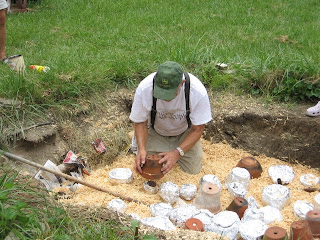The old way to make pottery was to dig a hole in the ground, a "pit", put the raw pottery in it, start a fire in the hole, and let the clay pots bake in the coals for several days. To add interest to our projects, we used all sorts of natural and chemical additives: coffee grounds, horse hair, Miracle Grow plant fertilizer, copper sulfate, banana peels, and powdered Jello, to name a few.
I was 30 minutes late in arriving, and storm clouds were brewing. Water is the enemy of a pit fire, and I was exhorted to "Hurry up and decorate" so we could get the fire going before the rains came.
This one, made of brown clay, has splashes of black oxide glaze, a sprinkle of Jello, and is about to be wrapped in horse hair and a rag that had been soaked in copper sulfate solution.

I painted some details on this white clay pot with a bronze metallic paint, and added coffee grounds. The hemp rope is supposed to "do something interesting," though nobody could tell me exactly what.

I filled the pot cavity with crumpled up newspaper and tied the whole thing with hemp rope. Next, it will be wrapped up tightly in aluminum foil.
Another white pot was decorated with copper metallic glaze and tied up with hemp. It was the last of the 5 or 6 pots that I did, and by this time, I was beginning to understand what I was doing. I hope this one will actually look like something.

Next, the aluminum-wrapped pots were placed in the sawdust-lined pit, looking like rows of baked potatoes.


To protect the more delicate items, clay flower pots were inverted over them, acting as a shield against heavy pieces of wood that might crash down. This is called a sauger. (Say it "sogger.")
 Or, at the studio, six women and a small boy.
Or, at the studio, six women and a small boy.Next, we added lots more crumpled newspaper and leftover scraps of dowel rods. Chemical "bombs," twists of newspaper with assorted chemicals, were scattered among the pots. When the heat strikes them, they explode, releasing who knows what into the pit. (Did I mention the element of faith involved in a pit firing?)

Everyone got to toss some wood on, even this little guy.

"Bring in the larger pieces of wood now."

Boss Peggy builds the fire just the way she wants it.

Adding smaller pieces to the top of the pile.

More wood, and some old rotted hay.
A great big brush pile, that's what.


The final touch - a good dousing with lighter fluid.

Peggy lights the first match.

Where there's smoke, there's fire. Or, is there?

Peggy, it's not looking so good.


















3 comments:
Fascinating! We have some potters in the area who pit fire, but I never really understood the process. Looking forward to the outcome.
Wow, can't wait to see how it all turns out.
I'm disappointed that you didn't choose to include horse manure in the "interesting items to add to the pit fire" list. You have a ready supply and everything!
Post a Comment